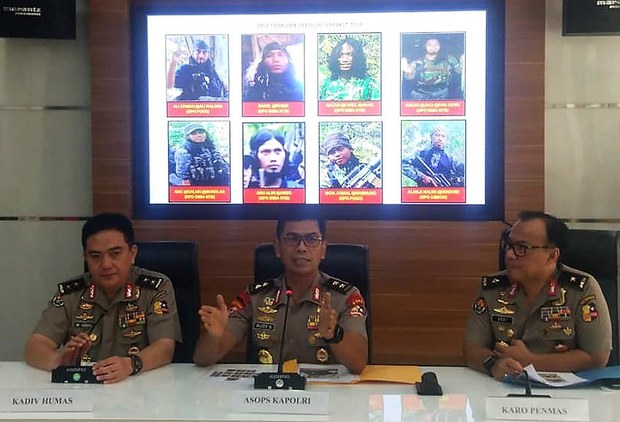Indonesia: MIT Militants Still Recruiting Despite Setbacks, Analysts Say
2019.03.25
Jakarta
 Indonesian Police Inspector-General Rudy Sufahriadi (center) speaks about wanted suspected members of the Eastern Indonesia Mujahideen militant group whose faces appear on an overhead screen during a press conference in Jakarta, March 4, 2019.
Indonesian Police Inspector-General Rudy Sufahriadi (center) speaks about wanted suspected members of the Eastern Indonesia Mujahideen militant group whose faces appear on an overhead screen during a press conference in Jakarta, March 4, 2019.
The Eastern Indonesia Mujahideen (MIT) group is a shadow of its former self after its leaders were killed or arrested in recent years, but the tiny band of militants linked to the Islamic State (IS) is capable of recruiting more members, analysts said.
Last week, government forces shot and killed three MIT suspects during a gunbattle in the jungles of Parigi Moutong, a regency of Poso district on Sulawesi Island where the group has operated for years, authorities said.
The killings brought to four the number of suspected MIT militants killed by security forces since early March, and reduced the group’s overall strength to only seven fighters, officials said.
But the group’s real strength is not known, analysts told BenarNews.
“At the grassroots level, efforts to mobilize people to join the group are still ongoing,” said Zaki Mubarak, a terrorism researcher at Syarif Hidyatullah Jakarta Islamic University.
“There have been people coming in from other regions.”
The three men who were gunned down on March 21 included two militants from the Maluku islands and Sumatra, who were wanted on suspicion of being part of the MIT group that operates in Poso and elsewhere in Central Sulawesi province, police said.
The authorities said they recovered several home-made bombs, 55 bullets and a saw from bags owned by the slain men.
The seven other MIT holdouts on the loose included the group’s current leader, Ali Kalora, officials said.
The remaining militants broke off into two groups to elude security forces taking part in the so-called Operation Tinombala, a security task force that has been hunting down MIT militants for years on Sulawesi.
Sidney Jones, director of the Institute for Policy Analysis of Conflict (IPAC) in Jakarta, cast doubt on police claims that MIT had only seven members left.
“We don’t know exactly their real number because they are constantly moving in the jungle,” she told BenarNews.
“The question is: is it possible that more people have joined without police knowing it,” she said.
MIT was no longer a big threat to stability but it was important for Indonesian authorities to keep pursuing its members, Jones said.
“Symbolically, Poso is important because it’s the only place where the pro-ISIS group can claim territorial control,” she said, using another acronym for IS.
‘Like two sides of the same coin’
Zaki said MIT has support from another pro-IS network blamed for recent terrorist attacks in Indonesia, Jamaah Ansharut Daulah (JAD), and from former members of Jemaah Islamiyah (JI), the group linked with al-Qaeda. Indonesian authorities blamed JI for the Bali bombings, which killed 202 people in 2002.
“Some elements at MIT have participated in military training in the Philippines sponsored by JI. JAD and MIT are like two sides of the same coin, very close,” he said.
Zaki said some residents of Poso and other areas in Central Sulawesi had shown sympathy to the group by providing food and failing to report members to the authorities. This was due partly to a history of deadly Muslim-Christian conflict there, Zaki noted.
In 2016, thousands of local people attended the burial of slain MIT leader Santoso and hailed him as a hero. Santoso, alias Abu Wardah, was killed during Operation Tinombala in July.
Santoso operated out of the surrounding mountains in Poso and conducted paramilitary training for militants, drawing recruits from within and outside the country, including at least six Uyghurs.
Two months after his death, his successor, Mohamad Basri, was captured. That same year, authorities announced that they had reduced MIT’s ranks from an estimated 40 people to fewer than 10.
The death of Santoso and the capture of his deputy significantly weakened the group, officials said.
Santoso was the first Indonesian militant to publicly pledge allegiance to IS.
Beheadings
During Santoso’s leadership, at least three farmers in the same district in Parigi Moutong were beheaded in 2015 – many of them non-Muslims from other parts of Indonesia.
In late December 2018, villagers in Parigi Moutong found a man’s head wrapped in a cloth that had been placed on a bridge. The victim was believed to be have been killed by MIT. When police went to recover the mutilated and headless corpse, gunfire broke out, injuring two of the officers, officials said.
Jones said she doubted that MIT would expand under the leadership of Ali Kalora, who was a foot soldier not seen as an ideologue.
The group also lacked funding and logistics to expand, Jones said.
Weapons smuggled in from the southern Philippines were hard to come by because of tightened border security and joint patrols involving forces from Indonesia, Malaysia, and the Philippines, the analyst pointed out.
In May 2017, pro-Islamic State militants took over Marawi city on Mindanao island in the southern Philippines, laying siege to the city for five months before government forces regained control.
At least 1,200 people – mostly militants – were killed. Much of the city was ruined during the battle between IS-linked gunmen and Philippine government forces. The takeover was the most serious assault by IS in Southeast Asia to date, and left governments across the region unsettled.
“There are too many security forces there. I don’t think they will be as big as they were two or three years ago,” Jones said, referring to Central Sulawesi.







